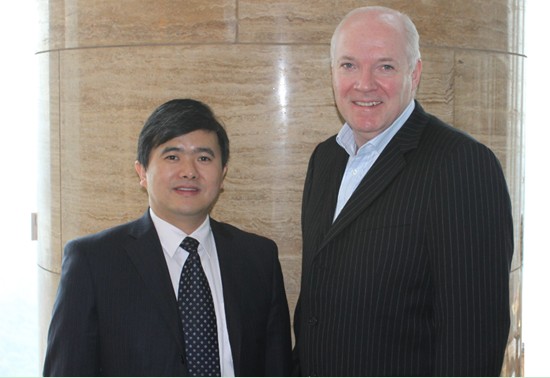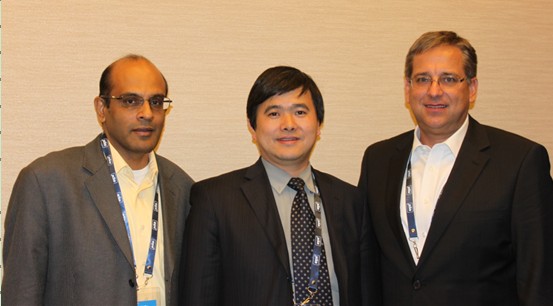Chinese Manufacturing: Enter Supply Chain Collaboration Era
Traditionally, the focus of Chinese manufacturers is to use ERP to facilitate improvements in operational efficiency and achieving lean manufacturing. Globalization of manufacturing has resulted in manufacturers needing to collaborate with retailers, distributors, logistic providers, suppliers, and customers. Therefore, manufacturers are increasingly interested in SCM application to realize the collaboration and optimization of internal supply chain with up and down stream enterprises. By collaborating they can better respond to the changes in customer demand, reduce supply chain cost, and realize an agile supply chain.

Mr. Hamish Brewer, the CEO of JDA
SCM applications are comprehensive and quantitative systems that assist the business to make decisions. What it takes to make an SCM Implementation successful? How to deploy SCM applications in manufacturing enterprises? How can SCM bring better ROI for manufacturers? With these questions in mind, Dr. Pei Huang, the editor-in-chief of e-works attended JDA's user conference FOCUS 2012 by the end of April 2012. JDA is the leading SCM software vendor in the world. During the conference, Dr. Huang interviewed JDA's executives, including Mr. Tom Dziersk, JDA's Executive Vice President of Sales and Marketing, Mr. Kelly Thomas, JDA's Vice President of Manufacturing, and Mr. Pari Annamalai, JDA's APAC Vice President of industry and pre-sales. Then, he interviewed Mr. Hamish Brewer, JDA's President and CEO in Nanjing, China. This paper is the summary of the interview. It provides valuable information for Chinese manufacturers in applying SCM systems.
1. The challenge of global manufacturers to manage supply chain
In the sluggish global economy, manufacturing industries have been increasingly competitive and most industries are faced with oversupply and reducing profitability. With this background, improving SCM capability is more important and more urgent for global manufacturers.
Mr. Hamish Brewer, the CEO of JDA pointed out: "The supply chain of manufacturing is becoming increasingly complex and volatile. Manufacturers find it more difficult to get the reasonable margins. In this situation, manufacturers are expanding into multiple channels to sell their products. They are employing multiple manufacturing models such as MTO or MTS and outsourcing manufacturing to enhance agility respond to customer's demand changes."
Mr. Tom Dziersk, JDA's Executive Vice President of Sales and Marketing said that European and American manufacturers are more focused on the reduction of labor cost through SCM to save supply chain cost, while Chinese manufacturers are more focused on efficiency in the supply chain than labor cost. However, as the labor cost is growing fast, Chinese manufacturing enterprises are becoming increasingly concerned with this issue.
OEMs have to collaborate with the upstream suppliers as well as the downstream distributors, logistics providers, and retailers. However, many OEMs still lack of collaborative attitude. Mr. Kelly Thomas, JDA's Vice President of Manufacturing said that: "When dealing with the relationship with suppliers, the concept of the procurement department in many enterprises is that: do what I tell you to do, don't ask. For example, formerly, American auto manufacturers always pushed their suppliers to lower price year over year and delayed payments to improve their own cash to cash cycle, which caused several suppliers to become bankrupt. This is obviously not a good way to get sustainable growth. Although the cash flow status of the factory improved, the problems have been transferred to their suppliers. Japanese auto manufacturers are doing better. They pay much better attention on building tighter partnership with their suppliers. TOYOTA has built up a true value supply chain. They know the significance of the supply chain value, but many American companies just optimized the process inside their company. Now this situation has been changed. American companies learned a lot from companies like TOYOTA and made improvements. However, today many Chinese companies haven’t realized the importance of supply chain collaboration."
In Kelly's view, it is also important for suppliers to know the change in demand so they can quickly response to these changes. For example, the collaboration between contract manufacturers like Foxconn and their clients is very important, because Foxconn has to understand the supply picture in multiple modes. For example, all the products of Apple are sent by air freight and need one or two day replenishment, while Lenovo and Dell ship most of the laptop products by sea to save cost so the replenishment cycle takes over 20 days. In both situations parties involved in the supply chain need to know the change in demand so they can replenish in time to meet demand.
For consumer products manufacturers, the collaboration with retailers is the base for improving service levels to retailers and improving forecast accuracy. It is critical for manufactures. P&G and Wal-Mart have developed a close collaborative supply chain partnership for sharing information.
According to Hamish, JDA has done a lot of work with Hyundai and GM working on developing their collaborative capabilities with their auto parts suppliers. In terms of collaboration with retail, JDA helped Black & Decker and the famous retailer Lowes to achieve supply chain information sharing. It is a win-win solution.

Dr Pei Huang is interviewing Mr. Hamish Brewer, the CEO of JDA
- Segment the supply chain and create unique relationships with suppliers and customers.
- For consumer goods industry, manufacturers should build close relationship with retailers and get information of the shelf level sales, so that they can drive supply chain by the change of real demand and get better understanding of the demand.
- Monitor supply chain data to analyze the long term ROI. Synchronize the supply chain information from customer through suppliers.
- Optimize the use of resources including fiscal assets, inventory, people, warehouses and transportation to improve the extended supply chain.
2. The JDA SCM way
Founded for over 27 years, JDA has formed complete SCM solutions, including order promising, inventory management, replenishment & fulfillment, demand management, transportation & logistics management, and shelf-connected cloud service. JDA has traditional advantage with S&OP, supply chain planning and optimization. JDA’s solutions also cover service chain management which includes spare parts management for manufacturing industry.
Founded in 1985, JDA's history can be divided into two periods. In the first 17 years after the foundation, JDA focused on ERP software and services for retail industry and became the leading supplier of retail ERP solution. In recent 10 years, JDA became the global leader of SCM solution. Tom indicated that: "We found there were serious inventory issues, replenishment issues, financial planning issue, so we made some acquisitions and greatly improved our planning and optimization solution." From retailing ERP vendor to Supply Chain Company, JDA made several important acquisitions, such as acquiring financial planning company Arthur in 1998, Intactix in 2000, Manugistics in 2006 and i2 in 2010. With these acquisitions, JDA provides "End to End" supply chain solutions. JDA's has achieved annual revenues of $657 million with 6,000 customers around the world, among which 1,500 retailers and 700 in distribution, and the rest are in manufacturing. Currently, JDA has 70 customers in Greater China, including Huawei, Lenovo, TCL and Suning etc.
JDA has grown through both organic growth and acquisition, and build an integrated SCM solution for manufacturers, distributors, and retailers, thus making it a global SCM leader. Hamish emphasized that "the strategy of JDA is to build the integrate portfolio and to support end-to-end supply chain process. Therefore, our SCM solution of manufacturing and retailing are gradually converging. What we are trying to do is enabling manufacturers with clear visibility down to the shelf through distribution and retail channels so that manufacturers can better respond to demand fluctuations and gain a better insight into consumer preferences in local markets. This will allow the manufacturers to manage their manufacturing capacity more intelligently to meet consumer preferences and demand. Therefore, our strategy for manufacturing and retailing is closely connected with each other, just like the two sides of the same coin. We tell the manufacturer that there is a lot of opportunity for you if you understand what's going on the retail shelf; and we say to the retailer there is a lot of opportunity for you if you help the manufacturer understand what's going on the shelf so that they can better service your distribution channel. "

Dr. Pei Huang interviewed Mr. Tom Dziersk (right) and Mr. Pari Annamalai (left)
Mr. Pari Annamalai, JDA's Vice President of Industries and Pre-sales pointed out that some top Chinese manufacturers like Lenovo and Huawei have built up their mature collaboration system with suppliers and customers. Lenovo, for example, has applied JDA's e-commerce solutions and executing S&OP planning, supply chain planning, and factory planning through JDA's software. By building up their own internal team, Lenovo can deploy JDA's factory planning, improve their business process, and develop add-on solution based on JDA SCM software. Some fast growing electronic appliance enterprises like TCL also ambitiously strive to realize supply chain planning and demand planning through applying SCM applications and to collaborate with customers effectively through applying CPFR (collaborative planning, forecasting and replenishment).
Pari thought that the enterprises not only need to improve in SCM technology application but also need to improve their SCM model and processes. So, when JDA is implementing SCM projects, they also provide consulting service. Pari pointed out that JDA's implementation methodology is to break the target into several critical deliverables which can be finished in 3 to 6 months one by one. Thus, when the project is completed, the enterprise already realized some business value. The modularized software architecture is the basis for JDA to support users' individualized configuration.
Dell is a big customer of JDA. Just like other computer OEMs, Dell started utilizing retail channels about four years ago. They have distributor channel for emerging markets, enterprise channel that they sell computers to companies, and direct channel through the web. Correspond to these different channels, JDA software offers different configurations to support various supply models of DELL. JDA has make to stock (MTS) model for retailers and distributor, make to order (MTO) model for enterprise users, and configure to order model for online sales.
Supply chain collaborative planning highly relies on the accuracy of the master data. Kelly said that: "Whether it is a mature market or an emerging market like China, data integrity is a basic issue that every manufacturer should face with. Bad data brings bad decisions. Of course, the accurate data does not mean 100% accuracy. By applying our systems, enterprises can quickly locate the problem and solve it. This is also the reason why many companies implement SCM project before ERP projects, because our system can organize data and simplify ERP implementation and speed the ERP implementation." JDA's SCM system can generate supply chain network chart so as to monitor and alert the company of risks in the supply chain.
Pari introduced JDA's SCM solutions in manufacturing industry. He pointed out that JDA has industry solutions for consumer products, semiconductor, hi-tech electronics, and automotive industries. The overall framework is similar but there’s special requirement in different industrial solutions. For example, the color of cars is the important factor of sequencing in automotive industry, but it is not so important for TVs.
3. The core of SCM: planning and optimization
Hamish said that: "In the past, Chinese manufacturers only paid attention to fast growth. But today as the companies become large and complex, the time is right for them to start to think about the application of advanced production planning and supply chain optimization to realize sustained growth with profitability. Over the next ten years, companies will not be focusing on the application of transaction systems like ERP gradually and will be more focused on the planning and optimization of supply chain." JDA is good at production planning and optimization, and the solution of JDA is around developing, improving, and maintaining the plan, whether it's a master production plan or the scheduling plan of individual plant.
Hamish pointed out that: "Planning is the main concern of JDA. We are helping enterprises to improve their planning capability, whether it's a master plan or a scheduling of a shop floor. The interface to our systems and other information systems such as ERP and MES drives the execution of these plans. Our primary value proposition is planning and optimization."

Mr. Kelly Thomas, JDA's Vice President of Manufacturing
For Huawei and Lenovo whose revenues over $20 billion and growing at a rate over 20%, they have large pressure on supply chain management. If they don't optimize their supply chain, very quickly their supply chain cost will go through the roof, which makes companies difficult to gain profits. Therefore, the core of JDA solution is planning and optimization of supply chain. For warehouse management, the solutions are relatively mature so JDA hasn't covered this solution.
4. Chinese manufacturing: Enter Supply Chain Collaboration Era
With the rapid growth of labor cost, the competitive strategy of Chinese manufacturers is transforming from low cost to differentiation. SCM can be used to help differentiate a company. SCM technology will play an increasingly important role in driving business as it did with Dell in their Dell Direct Strategy. Traditional supply chain barriers will be broken between suppliers and customers. The collaborative relationship with retailers, logistics providers, distributors, and parts manufacturers must be built up to share supply chain information and realize an efficient and agile B2B supply chain. Based on this foundation, planning and optimization should be implemented. In addition, Chinese manufacturing's transportation cost is much higher than international average, which can also be optimized through SCM technology. Therefore, we can see that the application of SCM technology is of great importance for Chinese manufacturing's transformation and upgrading.
Mr. Hamish indicated that: "Chinese manufacturers are just beginning to focus on the optimization of supply chain. In the past, most companies were focused on growth without the concern of cost. Today as the companies become global, large and complex, the time is right for them to start to care about the advanced planning and advanced supply chain planning to get sustainable growth with profitability. So I think it is the right time for JDA to start to be more active in China because we have 70 customers in China but we have 6,000 customers in the world which means that China accounts for little more than 1%. It should be more than that about 3% to 5%. In my view, SCM should be even more than 5% because China is the manufacturing engine of the world. I think hat over the next ten years Chinese companies will transfer their focus from ERP applications to scientific planning and optimization of manufacturing, so, JDA has great development potential in China."
For Chinese version, please visit: http://www.e-works.net.cn/interview/leader_373.htm








